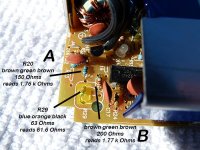Milou
1 W
dnmun said:you can either short it with a wire or just replace it with a wire. same difference since it will still be zero ohms.
[(63ohms/1881ohms) + 1] X 54V = 55.81V
but that is just an estimate, it really should be the ratio of the resistance of the (1881-63) out of the total when you remove the resistor. but i don't have that total, so i just guessed.
it would be interesting to see what happens when you jumper over that resistor, to see what the voltage ends up at.
I did as you said, used a jumper to by pass the resistor R29 at ~63 Ohms. First, I did unsolder one of its lead. The voltage output with the jumper is 56.5V. It seem to work as you said. And I assume it is very good? Do I keep it this way or replace it with another resistor? Thanks a lot for all your help. Regards JJ


